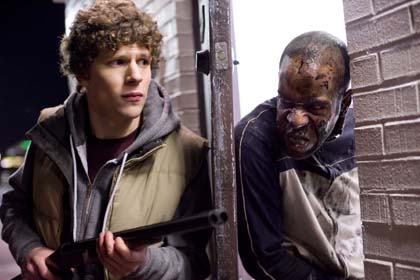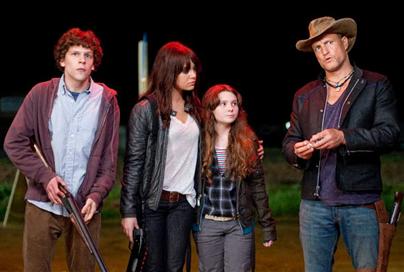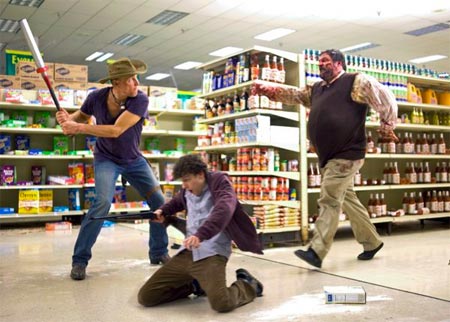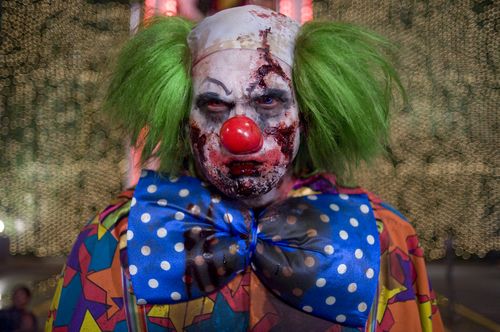Zombieland
 It’s been said that Russ Meyer primarily made silly exploitation movies filled with huge breasts, wild editing styles, and jokey narration because when he tried to make a real movie, such as The Seven Minutes, it would either be dull or devolve into camp, like his most famous films, Beyond the Valley of the Dolls, Cherry, Harry, and Raquel, and Faster, Pussycat! Kill! Kill! The suggestion was that he wasn’t a talented enough director to have a movie be taken seriously, so he had no other choice but to mock. The thing is, you can get away with a lot in a genre parody. If you’re mocking an action-comedy, as long as your movie is funny it becomes irrelevant if you can’t afford explosions or can’t direct car chases. Problems occur when you start believing you’re making a real movie and forget that the primary purpose of your film is to mock, not to be moving or exciting.
It’s been said that Russ Meyer primarily made silly exploitation movies filled with huge breasts, wild editing styles, and jokey narration because when he tried to make a real movie, such as The Seven Minutes, it would either be dull or devolve into camp, like his most famous films, Beyond the Valley of the Dolls, Cherry, Harry, and Raquel, and Faster, Pussycat! Kill! Kill! The suggestion was that he wasn’t a talented enough director to have a movie be taken seriously, so he had no other choice but to mock. The thing is, you can get away with a lot in a genre parody. If you’re mocking an action-comedy, as long as your movie is funny it becomes irrelevant if you can’t afford explosions or can’t direct car chases. Problems occur when you start believing you’re making a real movie and forget that the primary purpose of your film is to mock, not to be moving or exciting.
Edgar Wright didn’t remember this lesson while he was making Hot Fuzz, which while it has moments of humor, becomes an endless 2 hours of action clichés acted out as if they were genuine. It may seem funny to mock how long Michael Bay films are (Bad Boys 2 and the two Transformers films are right at the 2 ½ hour mark), but not enough to pad your film out with 40 minutes of repetition, easily excised. It was probably the success of his earlier film, Shaun of the Dead, that convinced Wright his impulses were always on the money. And indeed Shaun of the Dead is very, very funny for most of its running time, before it tries to legitimately scare us and make us care about its intentionally ridiculous characters in the third act. Shaun of the Dead recovers with a great closing scene that almost makes us forgot about all those standard zombie scenes that it didn’t do a thing with, how many times do we have to sit through that dilemma of whether or not you’ll be able to kill your family member or loved ones once they turn into the undead?
 Luckily Ruben Fleischer’s Zombieland, a film which he freely admits owes a lot to Shaun of the Dead, contains none of those familial zombie conversion complications, even mocking the notion as sappy, manipulative, and idiotic. Fleischer is smart enough to forgo the horror elements in Zombieland and always pushes the jokes to the forefront, which makes you forgive that a lot of them are considerably less clever than he and his screenwriters seem to think they are (“the first time I let a girl in my life and she tries to eat me”). The promising opening, with loner Jesse Eisenberg informing us that the world is now filled with zombies (mad-people disease) and there are a set of rules everyone should live by, is a perfect primer for what’s right with Zombieland. Showing us why cardio is important as a large man is chased down by sprinting dead people is funny, if obvious, but it guarantees that we won’t be left with a bunch of dimbulbs waiting to be picked off. This is reinforced by two interesting rules, don’t go to the bathroom, if you can avoid it (you’ll be cornered in the stall), and don’t be a hero, meaning that the best way to survive a zombie holocaust is to be svelte, humble, and constipated.
Luckily Ruben Fleischer’s Zombieland, a film which he freely admits owes a lot to Shaun of the Dead, contains none of those familial zombie conversion complications, even mocking the notion as sappy, manipulative, and idiotic. Fleischer is smart enough to forgo the horror elements in Zombieland and always pushes the jokes to the forefront, which makes you forgive that a lot of them are considerably less clever than he and his screenwriters seem to think they are (“the first time I let a girl in my life and she tries to eat me”). The promising opening, with loner Jesse Eisenberg informing us that the world is now filled with zombies (mad-people disease) and there are a set of rules everyone should live by, is a perfect primer for what’s right with Zombieland. Showing us why cardio is important as a large man is chased down by sprinting dead people is funny, if obvious, but it guarantees that we won’t be left with a bunch of dimbulbs waiting to be picked off. This is reinforced by two interesting rules, don’t go to the bathroom, if you can avoid it (you’ll be cornered in the stall), and don’t be a hero, meaning that the best way to survive a zombie holocaust is to be svelte, humble, and constipated.
 Eisenberg’s narration continues throughout the [refreshingly brief] film, but loses edge as it tries to tell us the emotions of the characters in an attempt to create conflict and drama, Eisenberg has a crush on self-sufficient and canny Emma Stone (always protecting her younger sister, played by Abigail Breslin), and seeing as there are only four characters in Zombieland, plus one major star cameo, we don’t need to be told anything, the economic tone of the movie demands that they will eventually get together. That leaves Woody Harrelson, nicely indulging in his completely silly redneck role as the obvious father figure (Fleischer tries too hard to make this issue literal), though it may have been funny if he felt that he ought to pair off with Breslin’s young teenage character, you know, for symmetry*.
Eisenberg’s narration continues throughout the [refreshingly brief] film, but loses edge as it tries to tell us the emotions of the characters in an attempt to create conflict and drama, Eisenberg has a crush on self-sufficient and canny Emma Stone (always protecting her younger sister, played by Abigail Breslin), and seeing as there are only four characters in Zombieland, plus one major star cameo, we don’t need to be told anything, the economic tone of the movie demands that they will eventually get together. That leaves Woody Harrelson, nicely indulging in his completely silly redneck role as the obvious father figure (Fleischer tries too hard to make this issue literal), though it may have been funny if he felt that he ought to pair off with Breslin’s young teenage character, you know, for symmetry*.
 Fleischer eventually ignores the need to tie things up neatly in favor of what we came to Zombieland for, creative ways to kill zombies. He and the screenwriters, Rhett Reese and Paul Warnick come up with some great variations, “the zombie kill of the week” (piano crushing), banjo to the face, etc. And when they run out of ideas on that front, they resort to bizarre movie references, such as the snakeskin jacket that Harrelson wears in the movie’s conclusion at an amusement park. The target audience for Zombieland is probably not the same as the one for David Lynch’s Wild At Heart with Nicolas Cage’s character and his snakeskin jacket that “represents a symbol of my individuality, and my belief in personal freedom.” Zombieland is not quite as goofy as Wild At Heart, certainly more restrained, and less technically accomplished (Zombieland has some truly terrible cinematography, the whole movie is muddy and cheap looking), but it’s more of a consistent piece of junk and certainly better than any American zombie film of the past few years. That may sound like faint praise, but well made trash that knows it’s trash is always going to be more fun and probably more memorable than a straight-faced genre movie. If he wasn’t waiting to be knighted into zombiehood himself, Russ Meyer would tell you the same thing.
Fleischer eventually ignores the need to tie things up neatly in favor of what we came to Zombieland for, creative ways to kill zombies. He and the screenwriters, Rhett Reese and Paul Warnick come up with some great variations, “the zombie kill of the week” (piano crushing), banjo to the face, etc. And when they run out of ideas on that front, they resort to bizarre movie references, such as the snakeskin jacket that Harrelson wears in the movie’s conclusion at an amusement park. The target audience for Zombieland is probably not the same as the one for David Lynch’s Wild At Heart with Nicolas Cage’s character and his snakeskin jacket that “represents a symbol of my individuality, and my belief in personal freedom.” Zombieland is not quite as goofy as Wild At Heart, certainly more restrained, and less technically accomplished (Zombieland has some truly terrible cinematography, the whole movie is muddy and cheap looking), but it’s more of a consistent piece of junk and certainly better than any American zombie film of the past few years. That may sound like faint praise, but well made trash that knows it’s trash is always going to be more fun and probably more memorable than a straight-faced genre movie. If he wasn’t waiting to be knighted into zombiehood himself, Russ Meyer would tell you the same thing.
*Anyone who has seen Eisenberg’s breakout role in Roger Dodger will probably find that sentence hilarious. The rest of you should probably just Netflix Roger Dodger.



